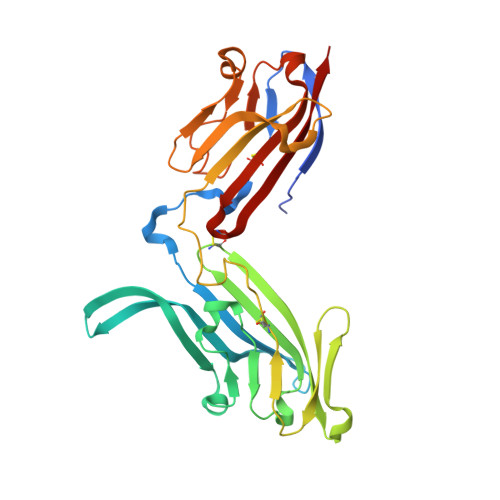An Evolutionary Insertion in the Mxra8 Receptor-Binding Site Confers Resistance to Alphavirus Infection and Pathogenesis.
Kim, A.S., Zimmerman, O., Fox, J.M., Nelson, C.A., Basore, K., Zhang, R., Durnell, L., Desai, C., Bullock, C., Deem, S.L., Oppenheimer, J., Shapiro, B., Wang, T., Cherry, S., Coyne, C.B., Handley, S.A., Landis, M.J., Fremont, D.H., Diamond, M.S.(2020) Cell Host Microbe 27: 428-440.e9
- PubMed: 32075743
- DOI: https://doi.org/10.1016/j.chom.2020.01.008
- Primary Citation of Related Structures:
6ORT - PubMed Abstract:
Alphaviruses are emerging, mosquito-transmitted RNA viruses with poorly understood cellular tropism and species selectivity. Mxra8 is a receptor for multiple alphaviruses including chikungunya virus (CHIKV). We discovered that while expression of mouse, rat, chimpanzee, dog, horse, goat, sheep, and human Mxra8 enables alphavirus infection in cell culture, cattle Mxra8 does not. Cattle Mxra8 encodes a 15-amino acid insertion in its ectodomain that prevents Mxra8 binding to CHIKV. Identical insertions are present in zebu, yak, and the extinct auroch. As other Bovinae lineages contain related Mxra8 sequences, this insertion likely occurred at least 5 million years ago. Removing the Mxra8 insertion in Bovinae enhances alphavirus binding and infection, while introducing the insertion into mouse Mxra8 blocks CHIKV binding, prevents infection by multiple alphaviruses in cells, and mitigates CHIKV-induced pathogenesis in mice. Our studies on how this insertion provides resistance to CHIKV infection could facilitate countermeasures that disrupt Mxra8 interactions with alphaviruses.
Organizational Affiliation:
Department of Medicine, Washington University School of Medicine, Saint Louis, MO 63110, USA; Department of Pathology and Immunology, Washington University School of Medicine, Saint Louis, MO 63110, USA.















